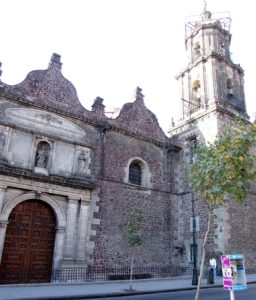Nearly 100 years before the Pilgrims arrived in present-day Massachusetts, Mexico was building one of its first hospitals: the Hospital de Jesús Nazareno, a facility which first opened its doors in 1524.
Today, the Mexico City hospital is a nonprofit and teaching institution. Its original interior tells quite a story adorned with intricately carved ceilings with golden accents of crosses and flowers. It was built nearly 500 years ago at the request of Hernán Cortés. There have been modern additions to the hospital but its charming courtyard, gray archways and a fountain remain intact.

The church that’s part of the Hospital de Jesús in Mexico City.
If the hospital’s walls could talk, they would tell many interesting stories. Here are a few.
In the beginning, the doctors who worked at Hospital de Jesús came from Spain. But one came from Ireland in a pirate ship, according to Dr. Julián Gascón Mercado, founder of the hospital’s school of nursing. In his book, “Breve Historia del Hospital de Jesús” (A Brief History of the Hospital de Jesús) Mercado tells the story of how in 1575, Dr. Guillermo Ricart was executed by the Catholic Church. His crime had nothing to do with piracy; the doctor was found guilty of being a Lutheran.
Then there’s the story of the hospital’s patronage. Patron was the title Pope Clement VII gave to Hernán Cortés, the Spanish conquistador who founded the hospital and wanted his descendants to run it in perpetuity. The pope agreed. And although it is a title associated with men, the hospital has had three women patrons.
The final story has to do with the multiple exhumations of Cortés’ remains.
Before his death in 1547, Cortés wrote in his will that he wanted to be buried in Mexico City. But he died in his native Spain. It took 20 years and two exhumations to get his remains to Mexico. Throughout the centuries, there have been several movements that have tried to erase his remains and even the monuments that honor Cortés, who was known for his violent conquering of Mexico.
Cortés’ remains have been moved a total of 10 times according to the hospital’s current administrator, Adrián Humberto Rivera Becerra.
His final resting place is El Hospital de Jesús, a place where no one is denied admission.
“At the Hospital de Jesús [we] assume there is goodness and there is evil in every person, as is the case with Hernán Cortés,” Becerra said. “His evil side is well documented and we don’t deny it. But, on his good side, we celebrate how he founded Mexico City and his vision for this hospital.”
Note: An earlier version of this story had an image caption crediting the mural in the Hospital de Jesús to José Clemente Orozco. The mural was actually painted by Antonio Gonzãlez Orozco.













